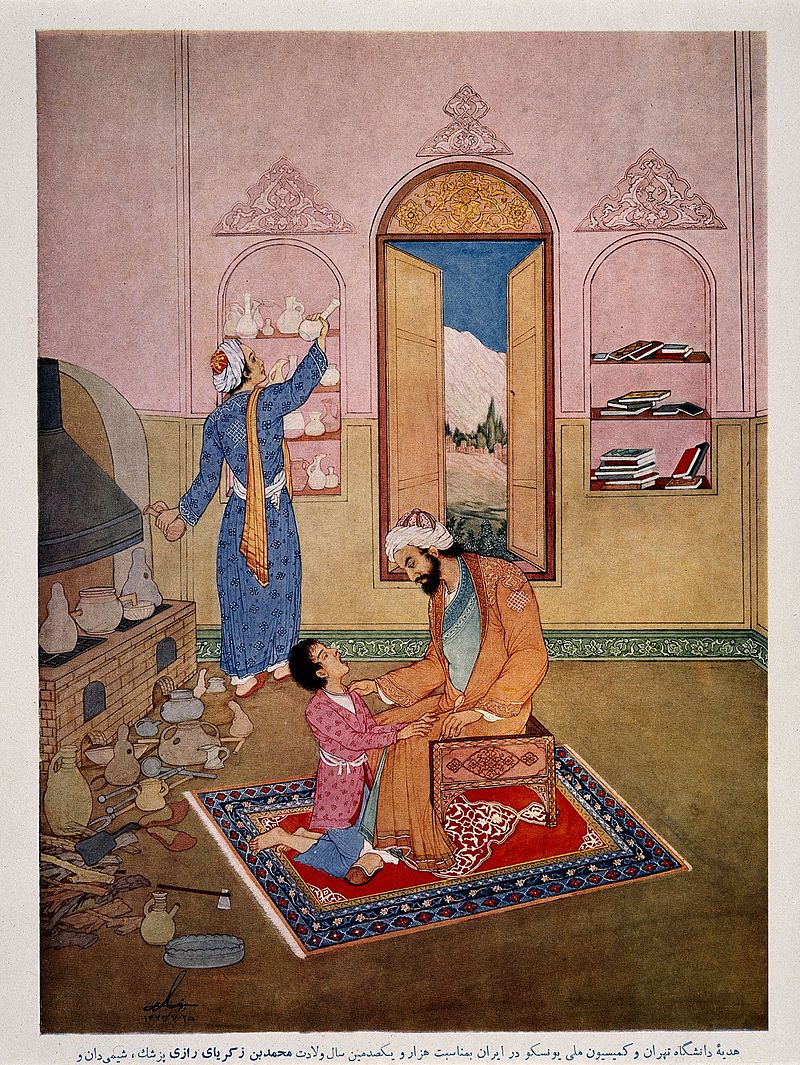Abū Bakr Muḥammad ibn Zakariyyāʾ al-Rāzī worked about 900 A.D. as a physician and alchemist. His primary work and fame comes from his work as a physician in describing diseases using the humor theory of Galen, pediatrics, and ophthalmology. He is from Iran, a city called Rey (al-Rāzī, ancient Rhagae) near Tehran.

al-Razi examining a patient (miniature painting by Hossein Behzad, 1894–1968)
He wrote extensively on medicine, some in philosophy, and 20 books (some no longer than pamphlets) on alchemy.
Wikipedia provides a good summary of his alchemical ideas:
Al-Razi's works present the first systematic classification of carefully observed and verified facts regarding chemical substances, reactions and apparatus, described in a language almost entirely free from mysticism and ambiguity.
- This book was written in response to a request from al-Razi's close friend, colleague, and former student, Abu Muhammad ibn Yunis al-Bukhari, a Muslim mathematician, philosopher, and natural scientist.
- Secret of Secrets (Sirr al-Asrar)
- This is al-Razi's most famous book. Here he gives systematic attention to basic chemical operations important to the history of pharmacy.
- In his book Sirr al-Asrar, al-Razi divides the subject of "matter' into three categories, as in his previous book Al-Asrar.
- Knowledge and identification of the medical components within substances derived from plants, animals, and minerals, and descriptions of the best types for medical treatments.
- Knowledge of equipment and tools of interest to and used by either alchemists or apothecaries.
- Knowledge of seven alchemical procedures and techniques: sublimation and condensation of mercury, precipitation of sulfur, and arsenic calcination of minerals (gold, silver, copper, lead, and iron), salts, glass, talc, shells, and waxing.
-
- This last category contains additional descriptions of other methods and applications used in transmutation:
- The added mixture and use of solvent vehicles.
- The amount of heat (fire) used, 'bodies and stones', (al-ajsad and al-ahjar) that can or cannot be transmuted into corporal substances such of metals and salts (al-amlah).
- The use of a liquid mordant which quickly and permanently colors lesser metals for more lucrative sale and profit.
- Similar to the commentary on the 8th century text on amalgams ascribed to Jabir ibn Hayyan, al-Razi gives methods and procedures of coloring a silver object to imitate gold (gold leafing) and the reverse technique of removing its color back to silver. Gilding and silvering of other metals (alum, calcium salts, iron, copper, and tutty) are also described, as well as how colors will last for years without tarnishing or changing.
- Al-Razi classified minerals into six divisions:
- Four spirits (al-arwah): mercury, sal ammoniac, sulphur, and arsenic sulphide (orpiment and realgar).
- Seven bodies (al-ajsad): silver, gold, copper, iron, black lead (plumbago), zinc (kharsind), and tin.
- Thirteen stones (al-ahjar): Marcasite (marqashita), magnesia, malachite, tutty (tutiya, zinc oxide), talcum, lapis lazuli, gypsum, azurite, haematite (iron oxide), arsenic oxide[which?], mica, asbestos, and glass (then identified as made of sand and alkali of which the transparent crystal damascene is considered the best).
- Seven vitriols (al-zajat): alum (al-shabb الشب), and white (qalqadis القلقديس), black, red (suri السوري), and yellow (qulqutar القلقطار) vitriols (the impure sulfates of iron, copper, etc.), green (qalqand القلقند).
- Seven borates: natron, and impure sodium borate.
- Eleven salts (al-amlah): including brine, common salt, ashes, naphtha, live lime, and urine, rock, and sea salts. Then he separately defines and describes each of these substances, the best forms and colours of each, and the qualities of various adulterations.
- Al-Razi gives also a list of apparatus used in alchemy. This consists of 2 classes:
- Instruments used for the dissolving and melting of metals such as the blacksmith's hearth, bellows, crucible, thongs (tongue or ladle), macerator, stirring rod, cutter, grinder (pestle), file, shears, descensory, and semi-cylindrical iron mould.
- Utensils used to carry out the process of transmutation and various parts of the distilling apparatus: the retort, alembic, shallow iron pan, potters kiln and blowers, large oven, cylindrical stove, glass cups, flasks, phials, beakers, glass funnel, crucible, aludel, heating lamps, mortar, cauldron, hair-cloth, sand- and water-bath, sieve, flat stone mortar and chafing-dish.
Wikipedia: Muhammad ibn Zakariya al-Razi
Razi did not accept Jabir's theory of Balance but did believe in the four elements and that they were transmutable using elixirs. He thought that glass and quartz could similarly be improved to rare gems. His book 'The Book of the Secret of Secrets' shows he is much more interested in practical alchemy than philosophical alchemy and reads almost like an laboratory manual.